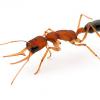The 2nd one could be a color variation of Tetramorium Immigrans...
- Formiculture.com
- Forums
- Gallery
- Members
- Member Map
- Chat

The 2nd one could be a color variation of Tetramorium Immigrans...
There is a important time for everything, important place for everyone, an important person for everybody, and an important ant for each and every ant keeper and myrmecologist alike
...and I have more ants to ID. Looks like a ponerine this time. 3 mm long, orangeish legs, blackish body. Maybe Hypoponera or Ponera? Sorry that the pictures aren't too good.
Edited by TheMicroPlanet, April 6 2020 - 11:48 AM.
Hypoponera or ponera.
Did some more research. Antmaps.org doesn't list any Hypoponera in NY, so I'll go with Ponera on this one.
I think Ponera is correct
Go to the ant, you sluggard; consider its ways and be wise! It has no commander, no overseer or ruler, yet it stores its provisions in summer and gathers its food at harvest. -Proverbs 6: 6-8
My Nationwide Ant Shop Here I have PPQ-526 permits to ship ants nationwide
Attention Ant-Keepers in South Dakota! Join the SoDak(Society Of Dakotan Ant Keepers)
If it's Ponera, it's probably P. pennsylvanica. No other ponerines up here besides P. pennsylvanica.
Edited by TheMicroPlanet, April 6 2020 - 12:23 PM.
Here they fly around the same time as Lasius neoniger. They don't really congregate, but they do land in random places.
"God made..... all the creatures that move along the ground according to their kinds (including ants). And God saw that it was good. Genesis 1:25 NIV version
Keeping:
Formica cf. pallidefulva, cf. incerta, cf. argentea
Formica cf. aserva, cf. subintegra
Myrmica sp.
Lasius neoniger, brevicornis
Two millimeters is quite small for parasitic Lasius.
I was snooping around my backyard and found a Lasius colony who's workers looked like the ones in the picture, but were maybe a full millimeter longer. I couldn't get any pictures, but could they be parasitic? I didn't see any signs of host workers. I'll check again tomorrow, and hopefully will get some pictures.
Mature parasitic colonies do not have host workers.I was snooping around my backyard and found a Lasius colony who's workers looked like the ones in the picture, but were maybe a full millimeter longer. I couldn't get any pictures, but could they be parasitic? I didn't see any signs of host workers. I'll check again tomorrow, and hopefully will get some pictures.Two millimeters is quite small for parasitic Lasius.
"God made..... all the creatures that move along the ground according to their kinds (including ants). And God saw that it was good. Genesis 1:25 NIV version
Keeping:
Formica cf. pallidefulva, cf. incerta, cf. argentea
Formica cf. aserva, cf. subintegra
Myrmica sp.
Lasius neoniger, brevicornis
That'd explain a lot. There were quite a number of workers under that rock.
The tetramorium usually just battle each other, and ignore other colonies. they have a sort of agreement with a formica colony that is maybe 8 feet away. The tetramorium colony could easily overcome it, but it does not. Tetramorium is very mysterious.
This is remarkably true. There are two Tetramorium colonies in my back yard that go to war every year. In fact, they were duking it out only a few weeks ago (they seemed to calm down when the weather got cold, though). I'm starting to realize just how much Tetramorium there is in my backyard.
0 members, 1 guests, 0 anonymous users